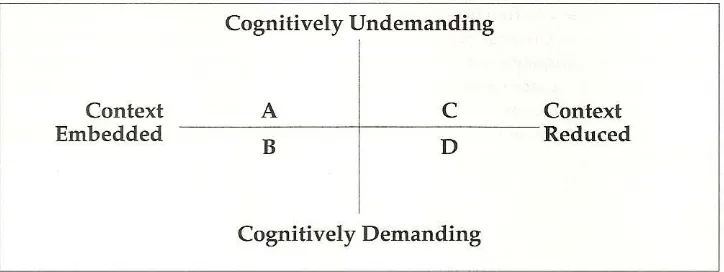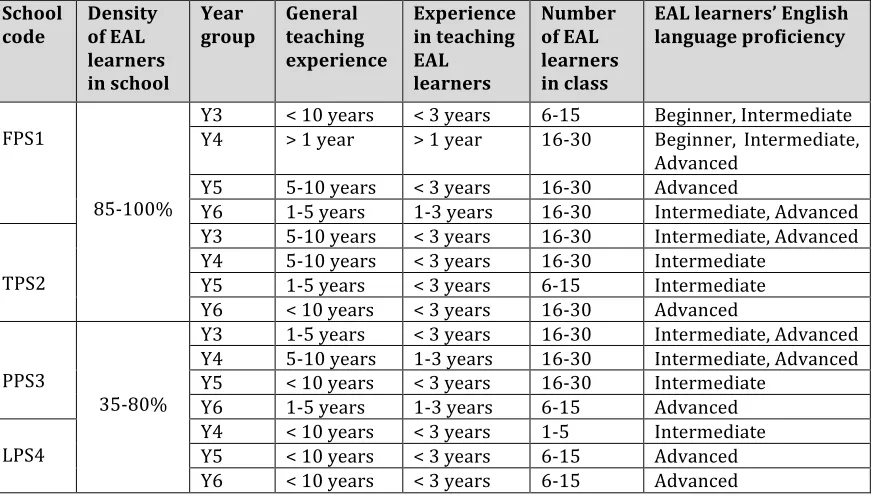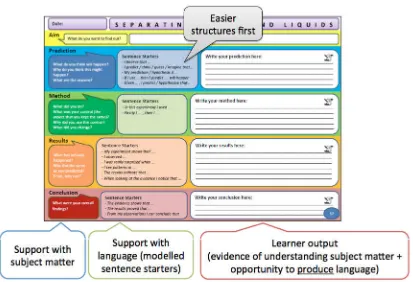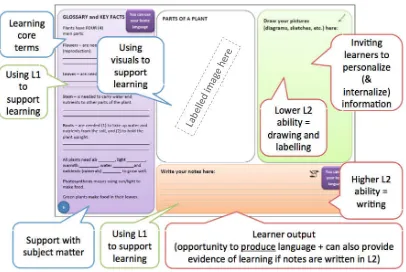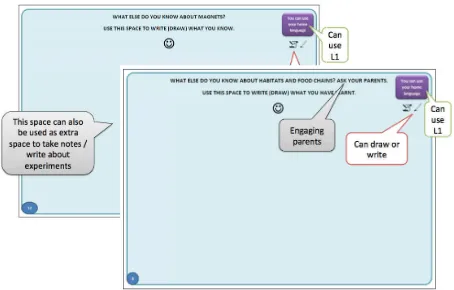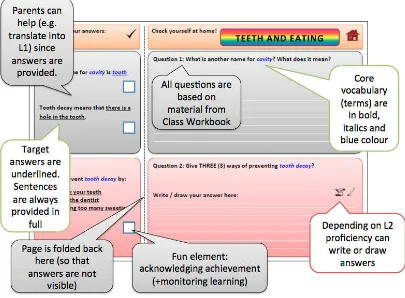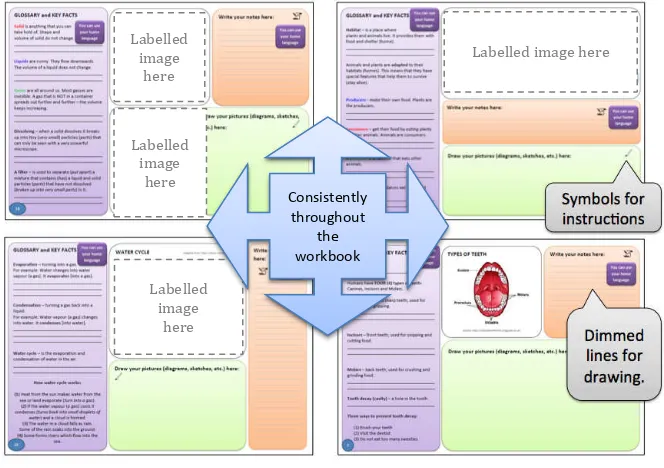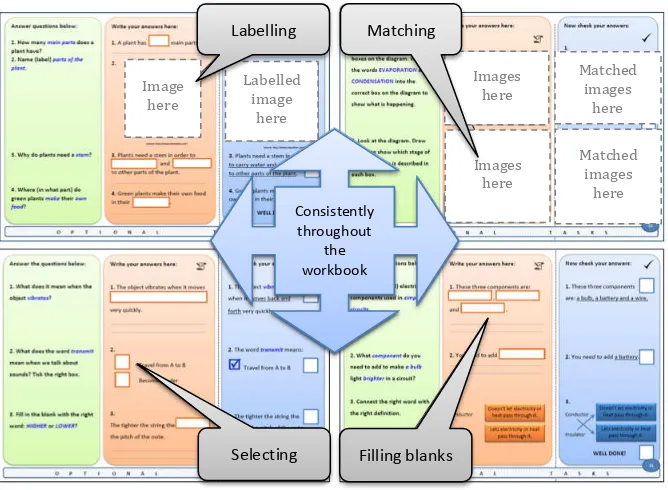This is a repository copy of Scaffolding learning: developing materials to support the learning of science and language by non-native English-speaking students.
White Rose Research Online URL for this paper: http://eprints.whiterose.ac.uk/91771/
Version: Accepted Version
Article:
Afitska, O. (2015) Scaffolding learning: developing materials to support the learning of science and language by non-native English-speaking students. Innovation in Language Learning and Teaching. ISSN 1750-1229
https://doi.org/10.1080/17501229.2015.1090993
eprints@whiterose.ac.uk https://eprints.whiterose.ac.uk/ Reuse
Unless indicated otherwise, fulltext items are protected by copyright with all rights reserved. The copyright exception in section 29 of the Copyright, Designs and Patents Act 1988 allows the making of a single copy solely for the purpose of non-commercial research or private study within the limits of fair dealing. The publisher or other rights-holder may allow further reproduction and re-use of this version - refer to the White Rose Research Online record for this item. Where records identify the publisher as the copyright holder, users can verify any specific terms of use on the publisher’s website.
Takedown
If you consider content in White Rose Research Online to be in breach of UK law, please notify us by
Innovation in Language Learning and Teaching
Title: Scaffolding learning: developing materials to support the learning of science and language by non‐native English speaking students.!!
!
Author: Dr. Oksana Afitska, University of Sheffield
Abstract: In recent years the UK, like many other English first language speaking countries, has encountered a steady and continuous increase in the numbers of non‐native English speaking learners entering state primary and secondary schools. A significant proportion of these learners has specific language and subject learning needs, many of which can only be addressed by: (a) specialised teacher training courses and (b) the use of academically appropriate, context‐ and language‐specific materials. At present, such materials are largely non‐existent for use in primary school contexts across the country. This article addresses this gap and proposes a set of innovative classroom‐based and take‐home materials aiming to support the teaching and learning of science at Key Stage 2 of the English National Curriculum. The materials were developed as part of an intervention research project conducted over a period of 24 months (2013‐2015) in four state primary schools in Sheffield with a varied density of English non‐native speaking learners. The materials were piloted with nearly 400 learners over a period of 10 months; the teachers were trained in using the materials prior to their trial. In this paper core features of the materials will be highlighted and their main functions discussed. Specific emphasis will be put on the following aspects: (a) support for language development, (b) support for subject knowledge development, (c) use of the first language in learning through the medium of a second language, (d) development of learner autonomy, and (f) promoting learning outside the classroom – making use of parental resources. The article will also argue that the proposed materials can be used equally effectively with non‐native and native English speaking learners.
Key words: materials development, content and language integrated learning, bilingualism, EAL, primary education.
Introduction
Since 1997 in England the number of EAL pupils, i.e. pupils who do not speak English as their first language, has doubled, reaching over a million, which accounts for more than a third of the entire state primary and secondary school population in the country (NALDIC, 2015). In the light of this steady increase of the EAL population in state schools, English education authorities have started developing EAL‐friendly materials to support mainstream teachers, who are often non‐EAL specialists, in educating EAL learners in their classrooms. This practice has recently become rather common at secondary school level. At primary school level, however, EAL‐friendly materials are largely yet to be developed.
subjects in a second language. These materials are similar in purpose to EAL materials. However, many primary school teachers in the UK are either unaware of them, do not have access to them, or find them linguistically or contextually inappropriate for their learners. For example, materials can be too simple or too advanced for a specific group of learners; some topics and facts which the English curriculum requires may be not covered; or the contents might be inappropriate for the English context. To take an example of contextual inappropriateness, Spanish CLIL science materials (Zarzuelo et al, 2006) also contain aspects of Spanish geography (e.g. ‘Landscapes of Spain’). In terms of linguistic inappropriateness, CLIL materials developed for use by learners at an ‘Intermediate’ level of target language proficiency are unlikely to be immediately suitable for ‘Beginner’ learners in England. There are also many web‐based EAL/ESL/CLIL materials (Crick, 2015; Catalonia, 2015; Asturias, 2015; the Basque Country, 2015; HTL Bildung Mit Zukunft, 2015) and EAL/ESL materials supplied by governmental and non‐governmental agencies (DfE, 2002; EAL Nexus, 2015, Collaborative Learning, 2015; NALDIC, 2015).
In order to make at least some use of existing EAL/ESL materials the teachers have to, first of all, find and then adapt them for use in their classrooms. Afitska and Clegg (forthcoming) report that this practice tends to be problematic for at least two reasons. Firstly, while the authors argue that ‘using a wide range of resources to develop one’s own materials for any group of learners is a good thing’, they warn that ‘the consistency and wholeness of such provision [can be] affected by the teachers’ searching and materials’ development skills’ (ibid). In other words, EAL learners in the schools where the teachers have ‘better’ materials searching and development skills are more likely to receive a broader ‘variety […] of EAL‐materials and [potentially more] knowledge embedded in them’ than learners in the schools where such good practices are not common (ibid). Secondly, often ‘the teachers […] do not have enough time to prepare high quality EAL materials for their English non‐native speaking learners’ as it can routinely take them anything between an hour to several hours to prepare for one lesson (ibid). Yet another common problem associated with the use of teacher‐developed EAL materials in the classrooms is that occasionally these materials insufficiently differentiate between the learning needs of the English language learners and those of learners with special educational needs or lower‐ achieving native‐speaking learners in the classroom (see also Driver and Ullmann (2011) on this issue). In the light of these problems, the project presented in this paper takes early steps towards the development of EAL‐ friendly materials for centralized use in primary classrooms across the UK.
Theoretical overview
helps them to use their cognitive resources effectively in the learning of both language and subject knowledge. Let us look first at the question of language for learning subjects.
It is important to clarify here that the concepts of ‘language support’ and ‘language acquisition’ are related, but different. They overlap, but involve slightly different procedures and aim at slightly different outcomes. This relationship is recognized in EAL/ESL, for example in the distinction between content‐based language teaching and sheltered subject teaching in the USA (Echevarriá et al, 2013), where the emphasis in sheltered subject teaching is on ‘making content comprehensible’, and in content‐based language teaching on helping learners develop their academic language proficiency. Helping children acquire language means exposing them to the target language in use, engaging them with it actively and giving them plentiful opportunities to produce it on their own in different contexts and stations. Language support for subject learning, on the other hand, means providing children with the linguistic items immediately needed to support their acquisition of the non‐linguistic content of the subject taught as part of the national curriculum. In this way language support is limited to the immediate application of the language in a given context. Language acquisition, however, goes beyond the immediate use of the language for subject learning and provokes learners, through extensive exposure to various linguistic forms, meanings and functions, to ‘notice’ how language is generally used in wide variety of situations and contexts. By such extensive and multiple exposures to the language, both explicit and implicit, language learners become aware of the gaps between their interlanguage and the target language and work towards closing of these gaps to help them improve their target language proficiency.
Of course, the type of language support described above may not support and facilitate language learning as effectively as explicitly‐focused language acquisition exercises and tasks can do. In mainstream content‐oriented classrooms (such as science, mathematics, physics) explicit teaching of language is not always possible and is not always needed. In immersion and EAL withdrawal classrooms, however, opportunities for extended exposure to the target language should always be provided.
they appeared in the text. The problem was that there were far too many unfamiliar words and the text was far too long and cognitively demanding for the learners of that age group. In this project, therefore, it was felt that what the teachers needed was further assistance with making the immediate subject content more linguistically and cognitively accessible to the learners by means of providing them with focused language support. A later goal of the project is to focus more on language acquisition by making the general linguistic content (written, recorded or teacher‐produced texts) more accessible to the learners through the provision of (a) the right doses of the target language in use and (b) more opportunities to use the target language in free and controlled situations.
The second aim of language support activities in the classroom is to allow learners to use their cognitive abilities efficiently. The cognitive resources of learners who learn subjects in a second language are often overstretched: they need to pay explicit attention not only to the new subject concepts but also to the new language in which these concepts are expressed. Learners working in their first language can often use their language abilities to a degree automatically: they do not always need to divert cognitive resources explicitly to focus on how to use language to process new concepts. Learners working in second language, however, need to do this if they are not yet fluent, and as a consequence learning can be slower and less effective than first language‐ medium learning. Language support, in providing learners with language resources, enables them to divert attention away from the new language and towards the new concepts. They need therefore to focus only on one thing rather than on two. There are many sources of language support, but the main source is the task, presented either on paper, on the board or electronically. Below I will discuss how language support tasks are constructed and how they interact with the cognitive demands of learning.
Language support tasks provide support for different language skills and at different language levels. Support tasks for receptive skills are by and large similar in type, as are support tasks for productive skills. Tasks for receptive processes, however, tend to focus less on grammar, since it is less salient in the process of comprehension than it is in language production. Productive tasks on the other hand are more demanding grammatically: learners need to direct mental resources to the construction of sentences and often need help in doing so.
also ‘context‐reduced’, i.e. they offer less – or indeed no – support in linguistic, visual and situational terms. They may also give no paralinguistic cues: learners may not be able to negotiate meaning, for example by showing in conversation that they do not understand. Individual tasks and written texts – especially those without visual support – can thus be more cognitively demanding than oral and especially group tasks, in which the learner may be able to talk to a teacher or a peer about meaning. A second language‐medium learner working successfully on a task in quadrant D must be fluent enough in the language to be able to meet the language demands the task makes fairly automatically and direct conscious attention to the conceptual matter. The less fluent the learner and the more mental resources s/he needs to direct to unfamiliar language, the more difficult this task will be.
[image:6.595.106.468.254.390.2]
Figure 1: Cummins (2000): balancing cognitive demands and contextual support
A task in quadrant C similarly offers little contextual support but learners need it less because the task is cognitively less demanding: it may require the learner to process material which is either familiar or cognitively simple. Learners who are less second language‐fluent and who need to think about language use while processing the concept matter, will find that they have more mental resources available to do so.
visual or interactional support in using their developing second language resources to acquire the new concepts. Quadrant B is therefore the main pedagogical domain in which second language‐medium learners and mainstream teachers who support them need to operate. It should be noted in passing that language support should normally aim to avoid making classroom tasks cognitively easier. It should not, in other words, be justifiable to suggest that EAL learners in mainstream classrooms are doing work which is cognitively less demanding than that of their L2‐fluent peers. Tasks presented to them should by and large remain in quadrant B. The purpose of EAL support is normally to preserve the cognitive challenge of learning but to make it linguistically more accessible.
Language support tasks, although extensively used in both EAL and CLIL are not widely described or discussed in the literature. Ball et al (forthcoming) and Dale et al (2010) do so for CLIL and a range of language support tasks for EAL in the UK is collected together at the Collaborative Learning website (http://www.collaborativelearning.org/). These tasks are not normally found in the pedagogical repertoire of subject teachers. Mainstream subject and primary class teachers will find some fairly easy to make. Others, however, such as some of those constructed within the framework of the project described in this paper, require training and experience and mainstream teachers cannot normally be expected to design them themselves.
The study
The data presented in this paper are derived from the EAL science project, a two‐year long collaborative research project between the University of Sheffield and Sheffield City Council (2013‐2015). Four state primary schools in Sheffield with a varied density of English non‐native speaking learners, comprising nearly 400 learners and 15 teachers, took part in the project. The development of a set of innovative classroom‐based and take‐home materials to support the teaching and learning of science to EAL learners at Key Stage 2 of the English National Curriculum was one of the project’s main goals. In order to achieve this goal, the material development ideas derived from existing ESL/EAL/CLIL practical and theoretical resources together with the project’s teacher interview data were combined to create a pilot version of materials for the use in target schools over a period of 10 months in the academic year 2014‐2015. These ideas were enriched by two collaborative materials development workshops involving the project’s lead researcher, a team of EAL specialists and consultants from Sheffield City Council, a group of primary and secondary school teachers working with EAL learners, and a materials development consultant.
Findings: Teacher interview data
their teaching contexts. The data were collected by means of semi‐structured interviews and were audio‐recorded. School code Density of EAL learners in school Year group General teaching experience Experience in teaching EAL learners Number of EAL learners in class EAL learners’ English language proficiency FPS1 85‐100%
Y3 < 10 years < 3 years 6‐15 Beginner, Intermediate Y4 > 1 year > 1 year 16‐30 Beginner, Intermediate,
Advanced Y5 5‐10 years < 3 years 16‐30 Advanced
Y6 1‐5 years 1‐3 years 16‐30 Intermediate, Advanced
TPS2
Y3 5‐10 years < 3 years 16‐30 Intermediate, Advanced Y4 5‐10 years < 3 years 16‐30 Intermediate
Y5 1‐5 years < 3 years 6‐15 Intermediate Y6 < 10 years < 3 years 16‐30 Advanced PPS3 35‐80%
Y3 1‐5 years < 3 years 16‐30 Intermediate, Advanced Y4 5‐10 years 1‐3 years 16‐30 Intermediate, Advanced Y5 < 10 years < 3 years 16‐30 Intermediate
Y6 1‐5 years 1‐3 years 6‐15 Advanced
LPS4
Y4 < 10 years < 3 years 1‐5 Intermediate Y5 < 10 years < 3 years 6‐15 Advanced Y6 < 10 years < 3 years 6‐15 Advanced
[image:8.595.80.516.89.337.2]
Table 1: Descriptive teacher data by school
The teacher interview data reveal several components that the teachers felt were important for inclusion in EAL‐friendly materials. It should be noted that when talking about language use in their science lessons, the teachers are not suggesting that language activities are in any way separate from science tasks, but see them as an accompaniment to teacher demonstration and practical learner activities.
T: Giving them lots of names of materials, names of properties – hard, strong, smooth, transparent, translucent, opaque – giving them all these words prior to the lesson starting, talking about it (TI‐Y3‐H‐TPS‐18.10.2013)
T: for me the most helpful thing would be if you took this unit for instance for year 4 and somebody had made a vocab sheet or a picture and answer you know to go with that at the beginning or work you know TA could spend time with those specific children in the classroom (TI‐Y4‐H‐TPS‐18.10.2013)
The purpose of drawing learners’ attention explicitly to core scientific terms was seen as ensuring that learners: (a) could differentiate more or less effectively between these terms during the opening, or presentation, phase of the lesson (use of picture cards), and (b) could use them more or less independently during the more practical stages of the lesson, such as completion of individual written work (use of vocabulary sheets for spelling) or as a part of group work activities (use of picture cards to support and facilitate scientific talk).
The next most useful component for inclusion into EAL materials mentioned by the teachers, and probably most appropriate for EAL learners with at least a lower‐intermediate level of English language proficiency, was the use of a glossary, whereby core scientific terms were not merely named or visually presented but were also explicitly explained and defined.
T: Most likely, definitions and also a glossary at the back. […] Like a glossary in the back, to go with the key words that go in there, or maybe different, like the water cycle, or life cycle, like diagrams in there, different things (TI‐Y4‐H‐FPS‐ 21.10.2013)
T: it will be good just to have like a sheet that has all key words, definitions, pictures (TI‐Y5‐H‐TPS‐18.10.2013)
During the interviews some teachers have also emphasized the importance of (a) explaining and clarifying and (b) exploiting less scientific, more everyday,
words in order to exemplify or define ‘more’ scientific concepts and ideas.
T: The equipment and the materials that you’re going to be using that day, with the pictures or the actual thing, with something stuck on, or a word stuck on it… I mean if it floated, you know, such and such ‐ floats, such and such ‐ sank, things like that (TI‐Y3‐H‐FPS‐21.10.2013)
T: if you have key words with a picture to say these things are rough, these things are rigid, so they have an idea, they can link words with pictures (TI‐Y3‐ H‐TPS‐18.10.2013)
supporting these learners’ productive skills, i.e. the skills needed to help these learners effectively talk and write about the acquired content of the lesson. The suggestion for the materials was thus the inclusion of examples of well‐ formulated scientific statements and sentence starters to help learners express and record their ideas using subject‐specific (i.e. scientific) discourse.
T: [They need] more support with how to record it (experiments), how to interpret the results in English (TI‐Y5‐H‐FPS‐21.10.2013)
T: […] some sort of sentence starters as to what they’re seeing (TI‐Y3‐H‐FPS‐ 21.10.2013)
T: I would quite like […] a structure of what a good prediction looks like, a good investigation… because [they] can carry them out, it’s the recording of it, like scientifically, what should it look like, what steps that the kids should go through, say you should have like a prediction, a conclusion, a methods and stuff… but how would that look for Year 3, that kind of what I would like, these kind of things (TI‐Y3‐M‐PPS‐18.11.2013)
Finally, the teachers’ views on the appropriateness of the use of learners’ first language in EAL‐friendly materials were elicited. The teachers’ standpoints on this topic were threefold. Some teachers believed that learners would benefit from dual‐language use, i.e. the use of English language and the learners’ first language, in the materials. Such dual‐language use, from the teachers’ point of view, would allow learners better to comprehend scientific content expressed via the medium of English language by making links to appropriate parts of contextually identical statements expressed in their first language (assuming that the learners are literate enough in their first language).
T: I think it’d be beneficial to have both languages, because obviously they can read it in their own language, but they can also see what it is in English, which I think would be very beneficial. Because obviously when as they get older, they are not going to have everything available in their own language… on the first attempt it would be beneficial maybe to have it in dual language, so they can see it in their language, see it in English, and say every time they see this, they know it means this. (TI‐Y4‐H‐FPS‐21.10.2013)
T: Sometimes giving it to them [children] in their own language and English does make it a little bit more easier because if a child let’s say is completely new to English and you said ‘where is the head’ they do not have a clue but if it was a person who spoke in Slovak for example and he said in Slovak ‘where is the head’ and if you pointed to it then and say in English ‘head’ so you got that link you know, that would make life a little bit more easier… but it depends, it will depend on what it is that you are teaching (TI‐Y3‐H‐TPS‐18.10.2013)
new arrivals, I think it would help them perhaps understand, it would probably help them understand it [concepts] better (TI‐Y6‐H‐FPS‐21.10.2013)
A second group of teachers, however, believed that learners, particularly those (a) in the earlier years of schooling, (b) with no‐ or limited‐ prior experience of education or (c) with limited exposure to the first language at home, particularly beyond its everyday usage (also see Afitska, 2015: 142‐143), would not be able to make any use of their first language, particularly in its written form, as they simply were not literate enough in it.
T: I don’t think it would be for my age group, because many of these children have never been to school in their own countries before, so they won’t be able to read or write in their first language. For the more able, for the higher schooling it might more helpful (TI‐Y3‐H‐FPS‐21.10.2013)
T: Sometimes giving them something in their home language makes it easier if the children know what that concept is or what language means in their home language … because a lot of the children do not speak a lot of those languages with the elders or their parents at home, so they only really know English (TI‐ Y3‐H‐TPS‐18.10.2013)
Finally, some teachers believed that the use of the first language in the classroom would not make much difference to the learners’ learning if their English language proficiency was higher than ‘beginners’ or ‘new arrivals’. They commented:
T: For the majority of pupils (whose English language proficiency is either intermediate or advanced) I do not think it would hurt, I think they would like it […] but they would not really need it (TI‐Y6‐H‐FPS‐21.10.2013)
T: I think it is alright if they are completely brand new but that is not appropriate later ‐ they do not need that (TI‐Y5‐H‐TPS‐18.10.2013)
The structural organization of the booklets was also informed by the teachers’ preferences. All teachers who had an opportunity to comment on this aspect preferred being provided with EAL‐specific stand‐alone activities as opposed to whole lesson plans with built‐in EAL support. The teachers’ reasoning and justifications for such preference are provided below:
T: personally I would prefer just activities because I teach in a way that is like very much ‘me’; so I feel like ‐ as long as I have the activities and resources then I could do it how I want it, rather than have a structured lesson (TI‐Y3‐M‐PPS‐ 18.11.2013)
T: Personally I would prefer set of activities for a specific topic, because if somebody else is going to give me a lesson I am not necessarily going to follow up that, I need to know what the objective is and I would need some ideas of the activities that would help me to meet that objective […] I probably would not follow somebody else’s lesson plan (TI‐Y5‐M‐PPS‐18.11.2013)
T: Definitely the activities, cos it is always harder to find an idea for an activity; if you got activities [then] you can use [them] as ideas… I think with planning… I personally prefer to plan myself cos I know what's in my mind, I do not generally feel that I can follow anyone else’s plan cos it’s not what I thought of, not [what] was in my mind, so it is harder to teach; whereas if it was activities I’ll be able to base my lessons on the activities, but plan myself and organize it myself (TI‐Y6‐M‐PPS‐18.11.2013)
Implications: Materials development
The repertoire of language support tasks, which is used in second language‐ medium education, (for example, in CLIL or EAL) includes tasks which give a very high level of support and those which give less. Substitution tables, for example, support speaking and writing skills by providing support at the levels of lexis, grammar and discourse. In other words, they require the learner to make very few language choices at all and direct mental resources almost entirely towards new conceptual content. Sentence starters give lexical and grammatical support. Writing/speaking frames give support at the discourse and lexical levels but not grammatically. A word list provides only lexical support, leaving the learners to construct both sentence and text. Similarly, receptive tasks vary in the degree of support they give and at the level of language at which it is given. Gap‐filling tasks, for instance, focus attention on vocabulary and cohesion. Diagram‐labeling focuses on vocabulary. Chart‐filling tasks draw attention to discourse structure. Some of these techniques have been adopted for the materials developed in this project.
ways, modelled examples of fully formed sentences were provided in the ‘comprehension‐check’ sections of their booklets (Figure 4).
[image:13.595.92.505.88.370.2]
Figure 2: Support for target language development
Support for subject knowledge development was provided by means of glossaries of key terms prior to each topic being introduced by the teacher. Language used in the definitions was simple to ensure as much comprehension as possible by the learners with lower levels of English language proficiency (Figure 3). Additionally, for each topic, less linguistically demanding means of knowledge access, such as visual prompts, were introduced to support comprehension of ideas and concepts. Where it was impossible to present an idea using a labeled picture or diagram, simple sentences and phrases were used to express the scientific facts. To support the learners’ understanding of experimental procedures and to help them decode meanings behind the technical names of experimental stages (such as: prediction, method, results, and conclusion), sets of leading questions using simple English language were introduced (Figure 2).
understanding and developing scientific ideas using their first language in two ways. Firstly, where the learners had sufficient literacy skills in their first language – as measured subjectively by the learners themselves – they were invited to write their understanding of the teacher’s explanations, as well as other ideas related to the topic from the lesson’s content, in the orange boxes in their booklets (Figure 3).
[image:14.595.92.498.157.429.2]
Figure 3: Support for subject knowledge development and use of first language to enhance learning
Where the learners did not have sufficient literacy skills in their first language to write in sentences or phrases, they were invited to draw or sketch, and probably label, their ideas in the green boxes in their booklets (Figure 3). The learners were also allowed to mix two languages – English and their first language ‐ in order to record their understanding so long as they felt happy and comfortable in doing so. It must be reinforced here that the main purpose of these booklets is not to assess the learners’ scientific knowledge (though some assessment, particularly assessment for formative purposes, is possible, see Figure 4). The main purpose of these materials is to support the learners’ comprehension of science as subject matter using whatever resources, linguistic or non‐linguistic, are available to them. Grammatical errors, errors in spelling, use of the first language, or the mixing of two languages should not raise (major) concerns at this stage.
partly in English (Figure 3). Secondly, the teachers could assess the degree of their learners’ understanding of scientific concepts by looking at their answers to the sets of simple comprehension‐check questions that accompanied each topic in the booklet (Figure 4).
[image:15.595.92.497.127.392.2]
Figure 4: Informal tracking of learners’ progress: opportunities for formative assessment
provided with such opportunities. For example, copying a scientific term letter by letter from a labeled diagram may help learners: (a) to remember the spelling of that word, (b) to link the ‘English’ name of the word to that in their first language, and (c) to re‐construct the understanding of English concept by drawing on existing knowledge about this concept from their first language.
[image:16.595.90.544.334.624.2]The materials also provided learners with opportunities to develop their autonomous learning skills. Learners can bring considerable knowledge and expertise from their general knowledge about the world into the classroom. It is a pity when these resources do not find application in the classroom. For non‐ native English speaking learners these resources are crucial ‐ they help ensure that learners do not get lost in the amount of highly technical scientific vocabulary and content that is being delivered to them by means of a (largely) unfamiliar medium of instruction. Encouraging learners to make use of their existing knowledge as well as training them in making the best use of this knowledge independently both inside and outside the classroom, can improve their chances of successful acquisition of any subject‐matter, not just science (Figure 5).
Figure 5: Development of learner autonomy inside and outside the classroom
daily life examples, in this way making these facts even more accessible and comprehensible to their children (Figure 5).
[image:17.595.92.497.96.394.2]
Figure 6: Use of parental resources to support learning
Concluding remarks
Even though the materials presented in this paper were primarily developed to support the language and subject content learning needs of learners with EAL, it is argued that they can be just as effectively used with English native speaking children in mainstream classrooms, and even more so with the children who may have additional learning needs. A good proportion of scientific terms and concepts taught as part of primary national curriculum is new to children regardless of their linguistic or cultural background. As one of the teachers commented:
In some cases it’s no different for a child who has got English as their first language because they have not come across those words either […] in a lot of cases … if they do not know what ‘gravity’ means it does not matter whether you are EAL or [a native speaker] (TI‐Y5‐H‐FPS‐21.10.2013)
supported learning practices and in the recording of learners ideas and knowledge (Figures 7 and 8).
[image:18.595.89.421.92.326.2]
Figure 7: Systematic and consistent presentation of scientific enquiry in booklets
The materials also observe good assessment practices. Informal knowledge‐ checking exercises, presented plentifully in the booklets, elicit learners’ knowledge in many different ways (Figure 8) and often reduce linguistic demands, allowing learners to demonstrate their knowledge and understanding in the ways most accessible and most appropriate to them.
Labelled image here Labelled
image here
Labelled image
here
Labelled image
here
Image Image
Image
Consistently throughout
the workbook
Consistently throughout
[image:19.595.92.426.42.287.2]
Figure 8: Reducing linguistic demands as part of informal assessment procedures
Needless to say, the development of such as these materials takes a considerable amount of time, effort and expertise. Ordinary teachers should not be asked or expected to develop such materials as part of their routine professional practices. The development of such materials should be a responsibility of educational authorities at the national level. In this way we are most likely to ensure consistent and high quality provision of support for EAL learners, and their teachers, in state primary classrooms in England.
References
Afitska, O. (2015) Talking about teaching and learning science in the EAL context:
interviewing teachers and learners in primary classrooms. In J. Conteh (2015) The EAL
Teaching Book: promoting success for multilingual learners in primary and secondary schools. London: Sage Publications Ltd, pp. 140‐145.
Afitska, O. and J. Clegg (Forthcoming, 2016) Supporting teachers in EAL classrooms: working towards the centralised provision of subject‐specific, EAL‐tailored resources for primary classrooms. The European Journal of Applied Linguistics and TEFL, Vol. 5, issue 1.
Asturias: Materials for Bilingual Learners (Online resource). Last accessed April 2015. http://web.educastur.princast.es/ies/sanchezl/archivos/materiales_dide1cticos.html
Ball, P., Kelly, K and Clegg, J. (Forthcoming). Putting CLIL into Practice. Oxford: Oxford University Press.
Basque Country: Content and Language Integrated Curriculum (Online resource). Last accessed April 2015. http://www.eleanitz.org/node/172
Image here
Labelled image
here
Labelling
Images here
Images here
Matched images
here Matched
images here
Matching
Selecting Filling blanks
Consistently throughout
Blair, A., Cadwallader, J. And Orge, I. C. (2014) Natural Sciences 2. Madrid: Oxford University Press España.
Catalonia: Content and Language Integrated Curriculum (Online resource). Last accessed April 2015.
Chamot, A. U. 2009. The CALLA Handbook: Implementing the Cognitive Academic
Language Learning Approach, Second Edition. White Plains, NY: Pearson.
Chamot, A. U., Cummins, J., Kahn, G. P., Sipkovich, V. and Weinberg, S. Scott. (2003)
Foresman Science Grade 3. Scott Foresman.
Collaborative Learning Project: Talk‐for‐learning activities for all subject areas (Online resource) Last accessed April 2015. http://www.collaborativelearning.org/
Crick Software. Clicker: Literacy without limits (Online resource). Last accessed April 2015. http://www.cricksoft.com
Cummins, J. (2000) Language, power and pedagogy: Bilingual children in the crossfire. Clevedon, UK: Multilingual Matters.
Dale, L., van der Es, W. And Tanner, R. CLIL Skills. Leiden: Expertisecentrum
Department for Education and Skills (2002) Access and Engagement. DfES. Accessible via: http://www.naldic.org.uk/eal‐publications‐resources. Last accessed April 2015.
Driver, C. and Ullmann, P. (Eds). 2011. NALDIC Quarterly 8.4. Reading: NALDIC ELSP (2015). http://www.elsp.ie/. Last accessed April 2015.
Echevarriá, J., Vogt, M. and Short, D. (2013). Making Content Comprehensible to English
Learners: The SIOP Model. Upper Saddle River, N.J.: Pearson.
HTL: Bildung Mit Zukunft (Online resources). Last accessed April 2015. http://www.htl.at/de/htlat/schwerpunktportale/clil_content_and_language_integrated _learning/samples_of_good_practice.html
http://srvcnpbs.xtec.cat/cirel/cirel/index.php?option=com_content&view=article&id= 45&Itemid=73
NALDIC: EAL Statistics. (Online resource). Last accessed April 2015. http://www.naldic.org.uk/research‐and‐information/eal‐statistics.
NALDIC: National Association for Language Development in Curriculum. (Online resource). Last accessed April 2015. http://www.naldic.org.uk/
EAL Nexus: EAL resources for the classroom. Last accessed April 2015. https://eal.britishcouncil.org/
